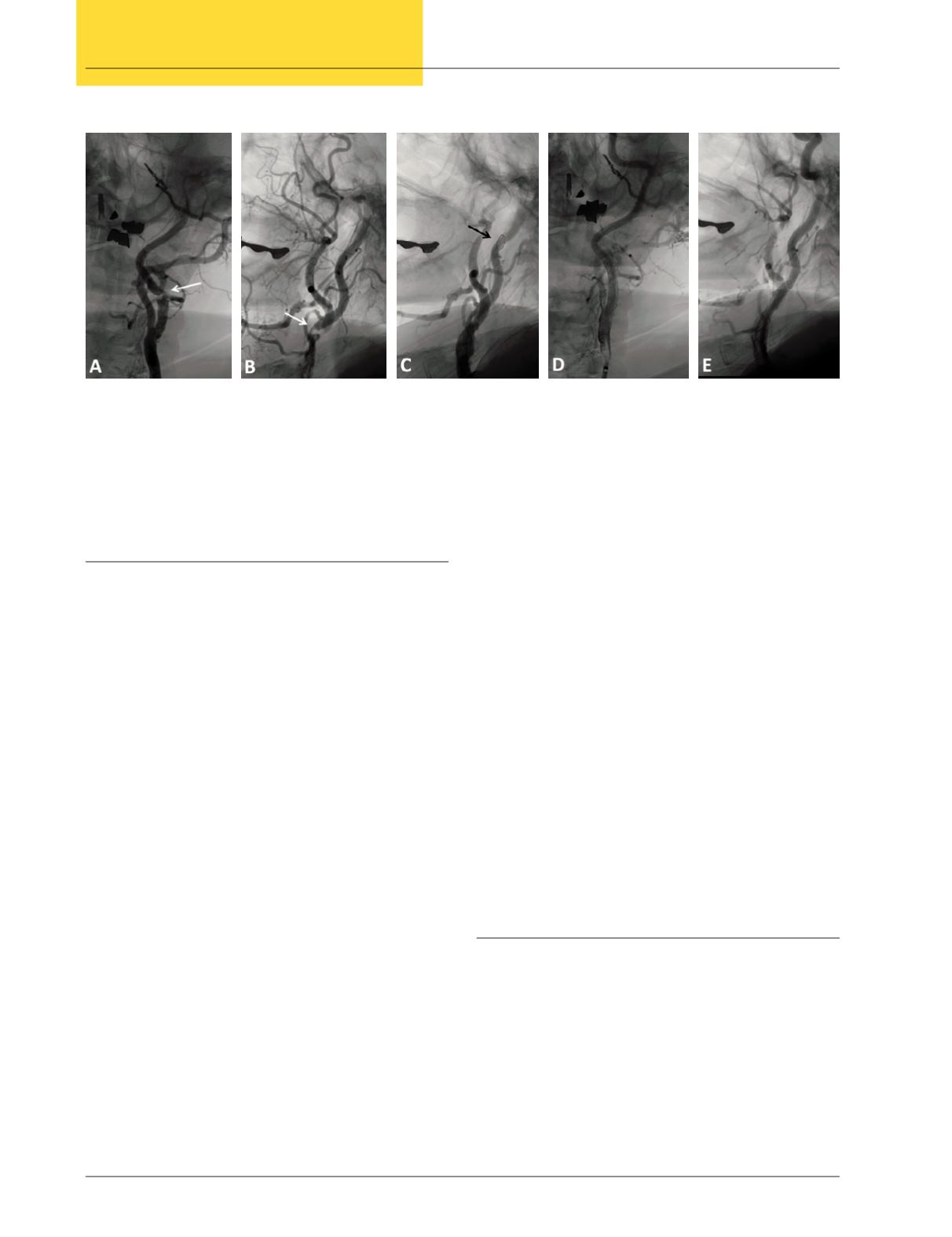
40
Vol. 66, No. 3 2015
Northeast Florida Medicine
Endovascular Neurosurgery
Procedure Overview - Key Points
The technique for CAS has evolved significantly since it was
first introduced in the 1990s and, similar to any procedure,
operator-related variability and technical nuances exist.
CAS is performed with biplane angiography with the
aid of 3-D rotational angiography (Figure 3). Before the
procedure, the patient is typically sedated but arousable
for neurological assessment. A percutaneous femoral artery
access is most commonly used to navigate the catheters, but
in selected patients a brachial or radial artery access may
be more beneficial.
23,24
Once the degree of stenosis is con-
firmed on contrast injections, a sheath or guiding catheter
is placed in the common carotid artery and the patient is
given heparin to obtain an activate clotting time (ACT) of
approximately 250 seconds. Before advancing the embolic
protection device (EPD), attention is paid to determining the
size of the patent lumen in the stenotic segment to facilitate
crossing of the lesion with the microwire and EPD. Sizing
the filter wire appropriately is also important to minimize
dislodgment of plaquematerial and to obtain circumferential
device apposition in the landing vessel. After the filter wire
and EPD catheter are in place, smooth inflation and defla-
tion of the entire stenotic segment using a coaxial balloon
catheter is accomplished (angioplasty). Arteriography is then
performed to evaluate the degree of stenosis post-angioplasty
and to search for embolic material in the distal filter system.
Angioplasty of lesions in the common carotid bifurcation
may cause overstimulation of the carotid body. Although
rare, severe bradycardia and hypotension may occur and
thus atropine and vasopressors must be readily available, as
well as continuous hemodynamicmonitoring with a femoral
sheath transducer or a radial artery line.
There are several commercially available carotid stents,
including balloon-expandable stents and nitinol self-ex-
pandable stents. Stent selection begins by measuring the
diameter of the stenosis, which is determined according to
the caliber of the largest segment of the carotid artery to
be covered. Sizing the stent correctly is important because
oversized self-expanding stents may cover a longer portion
of the vessel than initially anticipated and undersized stents
may be ‘floating in the vessel’ with increased likelihood of
developing thromboembolic complications. After the stent
is deployed, post-stent angioplasty may be performed to
improve stent apposition to the vessel wall. This maneuver
should be employedwith caution and only sparingly, because
plaquematerial can be dislodged and produce emboli. Lastly,
the EPD is removed using its retrieval catheter, followed by
final cervical and intracranial angiograms to assess immediate
stenting results and recognize distal embolic events.
Post-Procedure Management
Following CAS, patients require serial imaging surveil-
lance. Baseline carotid duplex ultrasonography is typically
performed before discharge and repeated at one month,
three months, six months, and yearly thereafter. In addi-
tion, dual-antiplatelet therapy of aspirin and clopidogrel is
mandatory after CAS for at least six weeks. After that time
period clopidogrel is usually discontinued and patients
remain on aspirin therapy indefinitely. Appropriate man-
agement of atherosclerosis risk factors is also paramount to
optimize patient care. Atherosclerosis is largely recognized as
Figure 3.
Digital subtracted angiography (DSA) demonstrates significant stenosis of the internal carotid artery on (A)
anteroposterior and (B) lateral views (white arrows). Revascularization with ICA stenting was indicated based on the severity of
the lesion. (C) DSA showing placement of the embolic protection device (filter wire) in the distal ICA to prevent embolic events
during stent deployment (black arrow). DSA depicting the ICA after placement of the stent and demonstrating restoration of
vessel patency in (D) anteroposterior and (E) lateral views.


